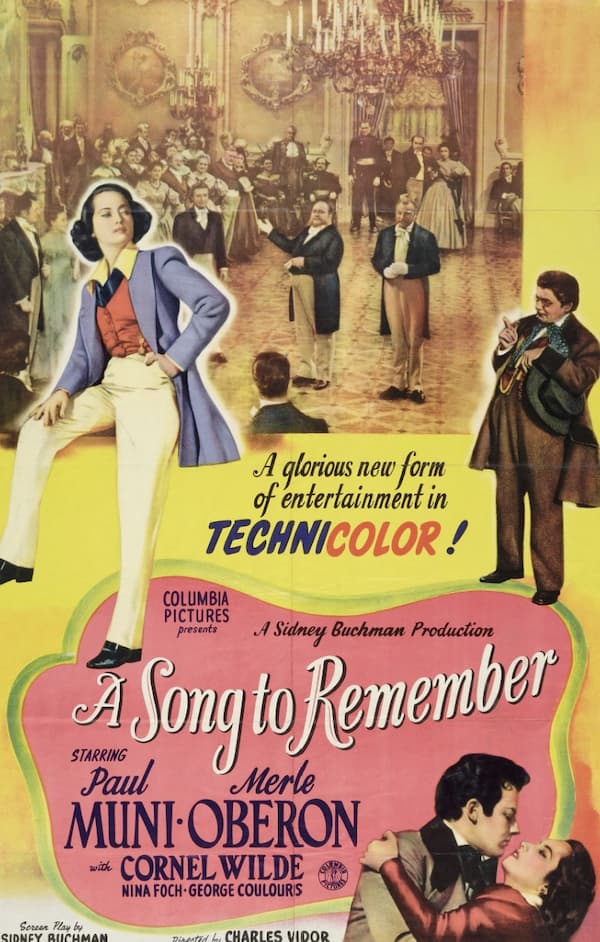In 1900, Grieg spent some time in Copenhagen, and he wrote to a friend, “although I am currently out of the country, my thoughts are only about Norway and Norwegians, about all our youthful pugnacity up there. Yes, it is like the music of strong triads compared to all the sugary seventh chords down here.”

Edvard Grieg
Grieg contemplated writing an article titled “What is Norwegian?” His definition suggested that “when Norwegian music is performed in such a way that it has the effect of strengthening the love of our country, so that people develop a better understanding of our native art, then the effort to achieve this result is dictated by nationalism. This I say from the bottom of my heart.”
However, Grieg got into trouble when he published an article titled “Cosmopolitan Confession of Faith” in 1889. This was in reaction to a Berlin critic writing that Grieg wanted to be “the virtual Messiah of Norwegian music.” Grieg had experimented with writing music with a “wider horizon,” speaking to a reporter about a more cosmopolitan way of writing music. “I have travelled so much,” he explained, “and have become more European, more cosmopolitan.”
It is against this seemingly conflicting background that Grieg set to work on the eighth volume of his Lyric Pieces. Published as Op. 65 in 1897, the set immediately gained great popularity and has since become of substantial pedagogical interest as well. While Grieg had started to grow somewhat weary of life and work, there are many examples in this set to show that inspiration had not abandoned him yet.
Edvard Grieg: Lyric Pieces, Book 8, Op. 65 – No. 1. Fra ungdomsdagene (From Years of Youth) (Marián Lapšanský, piano)
Edvard Grieg: Lyric Pieces, Book 8, Op. 65 – No. 2. Bondens sang (Peasant’s Song) (Marián Lapšanský, piano)
While “Melancholy” and “Salon” draw on harmonic subtleties as their most important element, the opening piece of the set “From Days of Youth” casts a backward glance full of despair and melancholy. The second, “Peasant’s Song”, and the fifth, “In Ballad Style,” delight with an unpretentious spontaneity found throughout the Lyric Pieces series.
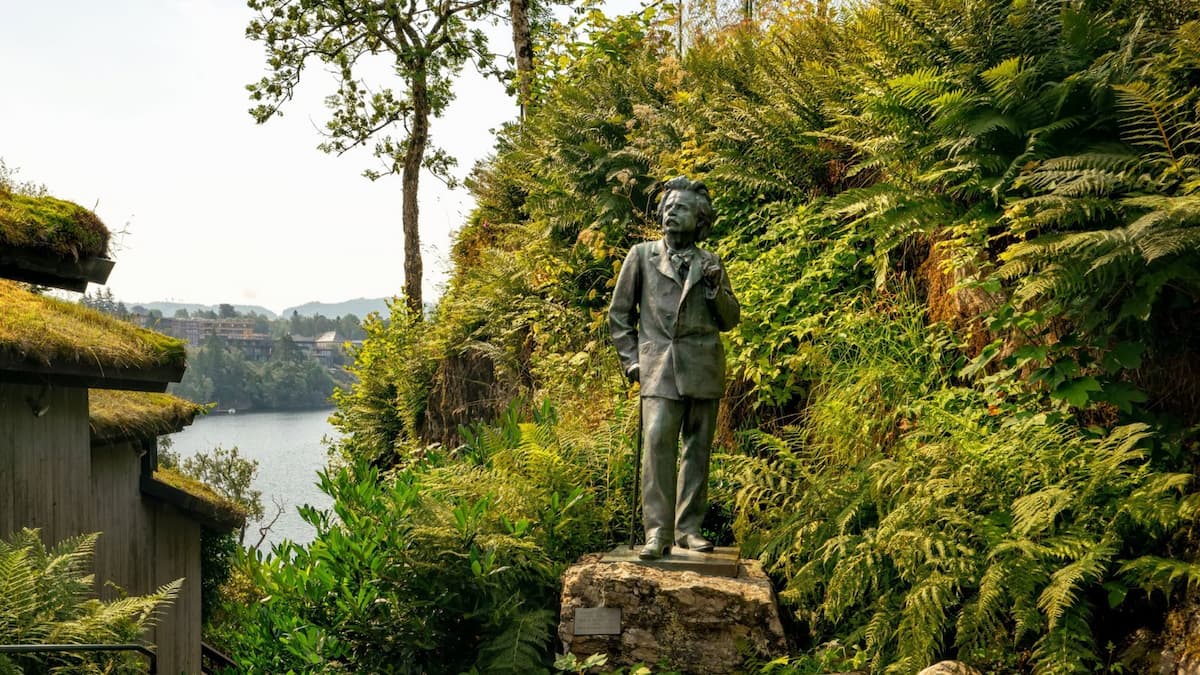
Edvard Grieg’s statue in Bergen, Norway
The Op. 65 set reaches a festive conclusion with “Wedding Day at Troldhaugen.” With this piece, more so perhaps than with any other piano piece, Grieg has won the hearts of the world’s amateur pianists. “It is exceptionally well conceived, as it sounds like a bravura piece demanding great technical skill from the performer.” In its contrasting midsection, Grieg once again draws on the loveliest lyricism inspired by Norwegian nature.
The piece was originally intended as a birthday gift to a friend, but it was actually composed in recollection of Nina and Edvard Grieg’s silver wedding anniversary. That day, 11 June 1892, proved a remarkable occasion. Nina and Edvard had prepared for a small party in the evening at Troldhaugen, but at noon, more than 100 guests arrived with the local train from Bergen for a reception in the garden.
Grieg was delighted until the party had to leave to catch the train back to Bergen. Impulsively, he climbed up on the garden table and invited them all back to be dined and wined in the evening. A neighbour called around the hotels in Bergen and ordered tables, chairs, glasses, tableware, and food. Everything was brought out to Troldhaugen as ordered, and, as Grieg wrote to a friend, “when the evening arrived, it was as in a fairy tale, everything was there. The party lasted long into the night. There were boats on the lake and bonfires on the islands, and Nina sang as Grieg accompanied her at the piano.”
Edvard Grieg: Lyric Pieces, Book 8, Op. 65 – No. 5. I balladetone (In Ballad Syle) (Einar Steen-Nøkleberg, piano)
Edvard Grieg: Lyric Pieces, Book 8, Op. 65 – No. 6. Bryllupsdag på Troldhaugen (Wedding Day at Troldhaugen) (Einar Steen-Nøkleberg, piano)
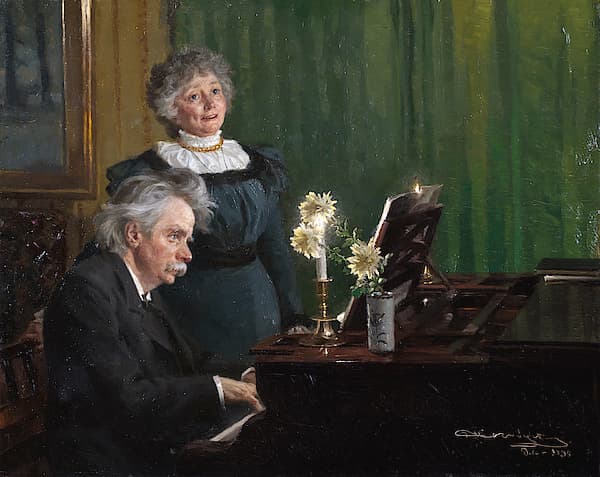
Edvard and Nina Grieg
By 1897, Grieg was involved in planning a large Norwegian music festival in Bergen. Grieg was looking to engage Willem Mengelberg and the Concertgebouw Orchestra of Amsterdam; however, critics suggested that a Norwegian Festival should feature Norwegian musicians. Grieg was adamant, declaring that Norwegian music should be played as excellently as possible, “whether this goal requires Norwegians, Germans, Japanese, or Dutchmen makes no difference to me.”
The initial committee disbanded, and the Festival was cancelled. However, wheels started turning behind the scenes, and Grieg was given authority to engage the Concertgebouw the very next morning. Thus, the Bergan Music Festival was born and first held from 26 June to 3 July 1898. It was a huge success, and “now, in both Bergen and Oslo, people are saying we must have a better orchestra! That, for me, is the greatest triumph!”
In terms of composing, however, Grieg was starting to feel the weight of his years as he completed the ninth and penultimate collection of Lyric Pieces, Op. 68. Published in 1899, the set contains a mixture of salon compositions laced with harmonic subtleties, such as “At Your Feet,” and the “Melancholy Waltz.” Here, Grieg leaves Norway behind and presents small gems of expressive beauty.
Edvard Grieg: Lyric Pieces, Book 9, Op. 68 – No. 1. Matrosenes opsang (Sailor’s Song) (Einar Steen-Nøkleberg, piano)
Edvard Grieg: Lyric Pieces, Book 9, Op. 68 – No. 2. Bestemors menuett (Grandmother’s Minuet) (Einar Steen-Nøkleberg, piano)
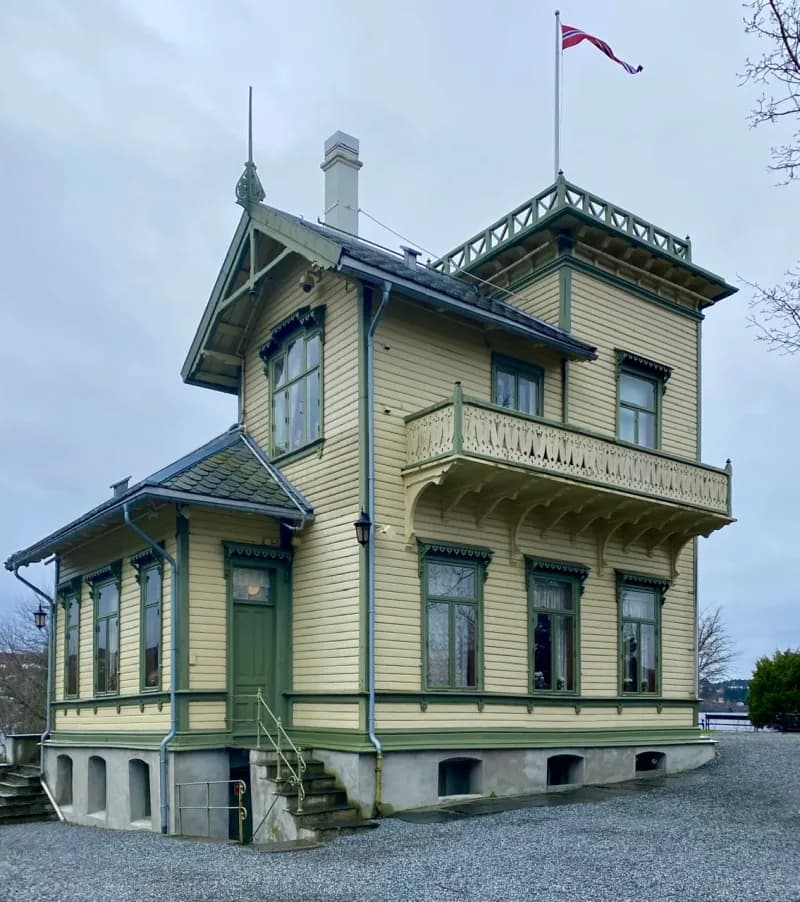
Grieg’s Troldhaugen
“Grandmother’s Minuet” is rather unusual, as it is written in unison octaves, and every note of its eighty-eight measures is marked to be played staccato. “At the Cradle” is a tender nursery song that only Grieg could have written; it almost cries out for lyrics. The star of the set, however, is the tender “Evening in the Mountains.”
He sent an early version to his friend Frants Beyer with the title “Cow Call” and with the inscription “Can be thought of as an evening in the mountain tops.” As he added in a letter, “just thinking of the mountain-tops, I feel that I can breathe more easily, and I am filled with a greater love of life.”
Grieg went on to arrange “Evening in the Mountains” for oboe, horn, and strings. He reports home from a concert in Amsterdam. “In Evening in the Mountains, I was thinking of you. It was an absolute mirage. Even I was thrilled. I had seated the oboist far back on the platform so no one could see him. He played so beautifully, so freely, so like an improvisation that when the magnificent string orchestra came in, it was as if they took their cue from the oboe, and the conception was identical.”
Edvard Grieg: Lyric Pieces, Book 9, Op. 68 – No. 5. Badnlat (At the Cradle) (Marián Lapšanský, piano)
Edvard Grieg: Lyric Pieces, Book 9, Op. 68 – No. 6. Valse melancolique (Marián Lapšanský, piano)
Grieg composed the last volume of Lyric Pieces, Opus 71, in the first half of 1901. With this volume, which is of consistently fine quality, Grieg brought his collection of small pieces for piano to a worthy conclusion. Perhaps understandably, this final collection is flavoured by a sense of melancholy and retrospection, while the composer’s harmonic language is at its most advanced.
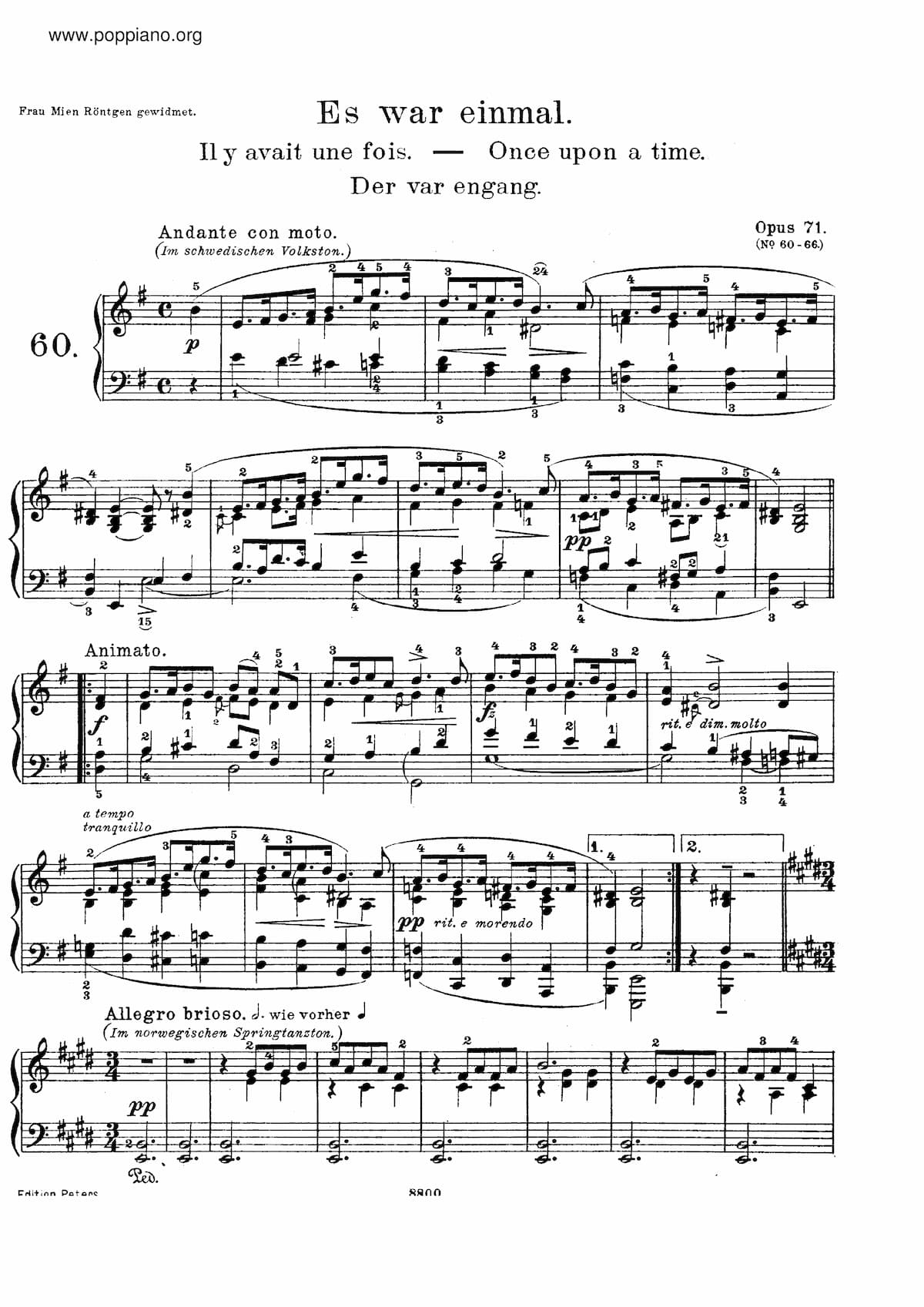
Edvard Grieg’s Lyric Pieces Op. 71 “Once upon a time”
Grieg certainly intended this set to be the conclusion as the last piece of the last book, “Memories”, uses a quotation from the first piece of the first collection, “Arietta.” As a pianist writes, “Now, however, it has been transformed into a vulnerable, melancholy waltz, of the type one might dance when the party is over, where, in spite of being a little intoxicated, one may try to maintain an image of propriety. In the end, everything just dies away.”
Edvard Grieg: Lyric Pieces, Book 10, Op. 71 – No. 1. Det var engang (Once Upon a Time) (Einar Steen-Nøkleberg, piano)
Edvard Grieg: Lyric Pieces, Book 10, Op. 71 – No. 2. Sommeraften (Summer Evening) (Einar Steen-Nøkleberg, piano)
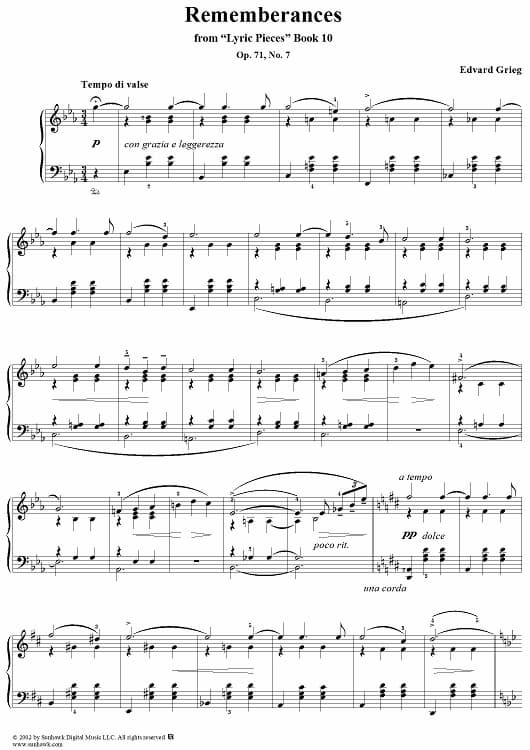
Edvard Grieg’s Lyric Pieces Op. 71 “Rememberances”
As in previous volumes, in “Summer’s Eve” and “Peace of the Woods,” Grieg created musical pictures of scenes in nature with fine sensitivity. “Puck and the virtuoso “Halling” are among the most genuinely Norwegian pieces Grieg had written. The volume is framed by melodious and nostalgic mood pieces, “Once Upon a Time,” “Gone,” and “Remembrances,” and concludes nearly forty years of writing in this particularly charming genre.
It was in his piano music that Grieg allowed the freest reign to his imagination, specifically in the Lyric Pieces. Many of them have highly picturesque titles, but Grieg never really composed program music in the sense that his music was supposed to follow a prescribed external course.
Essentially, we could call them “mood music,” often in the form of impressions of nature, but never an attempt to create a musical illustration of nature. The titles, in most cases, were added after the music was written. As a scholar writes, “When it was time to give a piece a title, Grieg tried to put himself in the place of the listener; the mood evoked by the music decided the choice of title.” I hope you have enjoyed our musical voyage through the Norwegian countryside with Edvard Grieg, and we might reasonably do further musical strolls with Sibelius, Gade, and Nielsen.
For more of the best in classical music, sign up for our E-Newsletter
Edvard Grieg: Lyric Pieces, Book 10, Op. 71 – No. 4. Skovstilhed (Peace of the Woods) (Marián Lapšanský, piano)
Edvard Grieg: Lyric Pieces, Book 10, Op. 71 – No. 5. Halling (Marián Lapšanský, piano)


